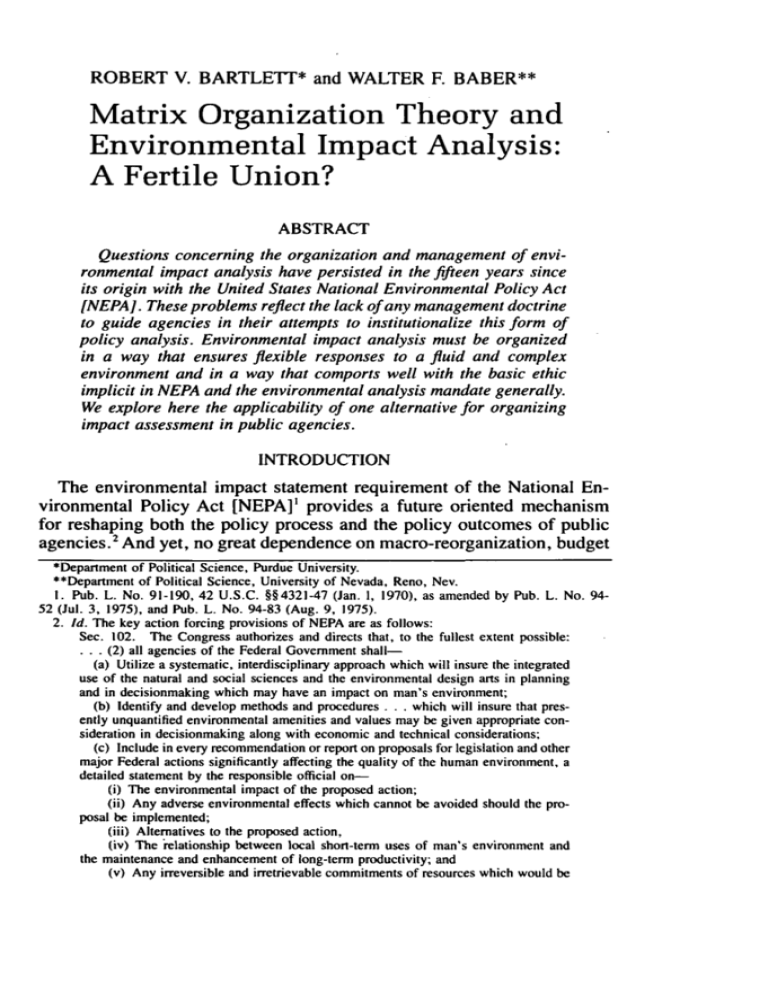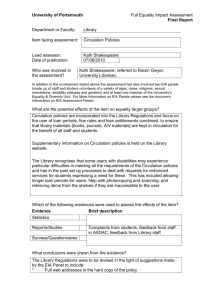Matrix Organization Theory and Environmental
advertisement

ROBERT V. BARTLETT* and WALTER F. BABER** Matrix Organization Theory and Environmental Impact Analysis: A Fertile Union? ABSTRACT Questions concerning the organizationand management of environmental impact analysis have persisted in the fifteen years since its origin with the United States NationalEnvironmental Policy Act [NEPAl. These problems reflect the lack of any management doctrine to guide agencies in their attempts to institutionalize this form of policy analysis. Environmental impact analysis must be organized in a way that ensures flexible responses to a fluid and complex environment and in a way that comports well with the basic ethic implicit in NEPA and the environmentalanalysis mandate generally. We explore here the applicability of one alternativefor organizing impact assessment in public agencies. INTRODUCTION The environmental impact statement requirement of the National Environmental Policy Act [NEPA]' provides a future oriented mechanism for reshaping both the policy process and the policy outcomes of public agencies. 2 And yet, no great dependence on macro-reorganization, budget *Department of Political Science, Purdue University. **Department of Political Science, University of Nevada, Reno, Nev. I. Pub. L. No. 91-190, 42 U.S.C. §§4321-47 (Jan. 1, 1970), as amended by Pub. L. No. 9452 (Jul. 3, 1975), and Pub. L. No. 94-83 (Aug. 9, 1975). 2. Id. The key action forcing provisions of NEPA are as follows: Sec. 102. The Congress authorizes and directs that, to the fullest extent possible: ...(2) all agencies of the Federal Government shall(a) Utilize a systematic, interdisciplinary approach which will insure the integrated use of the natural and social sciences and the environmental design arts in planning and in decisionmaking which may have an impact on man's environment; (b) Identify and develop methods and procedures ... which will insure that presently unquantified environmental amenities and values may be given appropriate consideration in decisionmaking along with economic and technical considerations, (c) Include in every recommendation or report on proposals for legislation and other major Federal actions significantly affecting the quality of the human environment, a detailed statement by the responsible official on(i) The environmental impact of the proposed action; (ii) Any adverse environmental effects which cannot be avoided should the proposal be implemented; (iii) Alternatives to the proposed action, (iv) The relationship between local short-term uses of man's environment and the maintenance and enhancement of long-term productivity; and (v) Any irreversible and irretrievable commitments of resources which would be NATURAL RESOURCES JOURNAL [Vol. 27 changes, or detailed administrative rules is anticipated.' By creating legal mandates, by arousing public opinion and focusing it through the generation of environmental impact data, and by altering the valuative environment and decision routines of public officials, NEPA seeks to alter the most basic premises underlying policymaking across a wide range of substantive issues.' But as with many other reform efforts in government, NEPA has produced a field of focus to which agencies can respond in a variety of ways.5 The organizational format6 that agencies choose in meeting the demands of NEPA for environmental impact analysis may, in fact, determine the extent to which the mandated policy analysis actually becomes an institutionalized reality in the decision processes of those agencies. And there are a variety of ways that implementation choices can affect this institutionalization. 7 Environmental impact analysis [EIA] must be institutionalized in a manner consistent with the metapolicy of NEPA if its reforming influence is to be felt at the level of agency implementation.' The openness of this question is evident in the fact that no orthodoxy has yet developed to guide the organization and management of NEPA-mandated environmental impact analysis. In a survey of employees of four federal agencies,' Bartlett asked about how the agencies had organized their environmental sciences expertise to implement NEPA.o Respondents were asked to characterize their ageninvolved in the proposed action should it be implemented. For a discussion of future oriented mechanisms for shaping policy processes, see Dryzek, Present Choices, Future Consequences: A Case for Thinking Strategically, 19 WORLD FUrURES I (1983); Dryzek, Don't Toss Coins in Garbage Cans: A Prologue to Policy Design, 3 J. PUB. POL. 345 (1983). 3. S. TAYLOR, MAKING BUREAUCRACIES THINK: THE ENVIRONMENTAL IMPACT STATEMENT STRATEGY OF ADMINISTRATIVE REFORM (1984); Caldwell, Is NEPA Inherently Self-Defeating? 9 ENVTL. L. REP. 50001 (1979); Caldwell, The Environmental Impact Statement: A Misused Tool, in ENVTL. IMPACT ANALYSIS: EMERGING ISSUES IN PLANNING (R. Jain & B. Hutchings ed. 1978); Dreyfus and Ingram, The National Environmental Policy Act: A View of Intent and Practice, 16 NAT. RES. J. 243 (1976). 4. Bartlett, Rationality and the Logic of the National Environmental Policy Act, 8 ENVTL. PROF. 105 (1986). See also several articles reprinted from the Natural Resources Journal in a 25th anniversary anthology entitled ENCLOSING THE ENVIRONMENT: NEPA's TRANSFORMATION OF CONSERVATION INTO ENVIRONMENTALISM, 25 NAT. RES. J. (1985). 5. L. CALDWELL, R. BARTLEIr, D. PARKER, & D. KEYS, A STUDY OF WAYS To IMPROVE THE SCIENTIFIC CONTENT AND METHODOLOGY OF ENVIRONMENTAL IMPACT ANALYSIS (1983) [hereinafter CALDWELL). 6. Herein, organizational format refers to the choice among various alternatives for assembling an agency's NEPA compliance personnel and placing them within the agency's structure. 7. S.HART & G. ENK, GREEN GOALS AND GREEBACKS: STATE LEVEL ENVIRONMENTAL REVIEW PROGRAMS AND THEIR ASSOCIATED COSTS (1980); ENVIRONMENTAL LAW INSTITUTE, NEPA IN ACTION: ENVIRONMENTAL OFFICES IN NINETEEN FEDERAL AGENCIES (198 1). 8. L. CALDWELL, SCIENCE AND THE NATIONAL ENVIRONMENTAL POLICY Acr: REDIRECTING POLICY THROUGH PROCEDURAL REFORM (1982). 9. The U.S. Forest Service, The U.S. Army Corps of Engineers, the Bureau of Land Management, and the Soil Conservation Service. 10. Bartlett, Science in the National Environmental Policy Act as Perceived by Agency Personnel: Organizational Arrangements, Personnel, and Bureaucratic Constraints, in CALDWELL, supra note 5. Summer 19871 ENVIRONMENTAL IMPACT ANALYSIS cy's EIA efforts according to the way those personnel responsible for NEPA compliance were organized. The responses were: a. Scattered among several staffs in the agency with primary responsibility for other tasks, but available for consultation (43.5%); b. Integrated in the basic planning groups or units (26.6%); c. Organized in separate "environmental experts units" under planning groups or units (12.6%); d. Organized in separate "environmental experts units" independent of planning groups or units in the formal organization chart of the agency (10.1%) e. Other (7.2%). No orthodoxy seems to have appeared on the subject of how to organize EIA efforts--either across or within agencies. Nevertheless, a preference seems to exist which calls for some organizing concept that neither subjugates impact analysis groups to planning units nor isolates them in the status of staff units. This leads to a hypothesis that some ad hoc administrative arrangement is desired, one that rationalizes and clarifies the status of EIA work groups without depriving them of their independence or the flexibility they need if they are to have significant impact on the agency's planning processes. The demand for such an approach could result from the purely pragmatic requirements for economical resource management and sufficient management control in an uncertain political and bureaucratic environment. It could be a preference resulting from the unique personal and professional characteristics of those involved in EIA work. Or it could relate to something more basic, an essential characteristic of environmental impact analysis as a human activity. We.suggest that each of these components of the ad hocracy hypothesis has merit. Environmental impact analysis must, therefore, be organized in a way that ensures flexible organizational responses to a fluid and complex environment and in a way that comports well with the basic ethic implicit in NEPA and the environmental analysis mandate generally. Whereas a great deal of effort has been invested over the last decade and a half in developing techniques and procedures for environmental impact analysis," little conceptual, theoretical, or empirical effort has 11. See, e.g., I. MCHARG, DESIGN WITH NATURE (1969); J. FABOS, C. GREENE, & S. JOYNER, THE METLAND LANDSCAPE PLANNING PROCESS (1978); Hill, A Goals-Achievement Matrix for Evaluating Alternative Plans, 34 J. AM. INST. PLANNERS 19 (1968); Y. HAIMES, W HALL, & H. FREEDMAN, MULTIOBJECTIVE OPTIMIZATION IN WATER RESOURCES SYSTEMS: THE SURROGATE WORTH TRADEOFF METHOD (1975); L. LEOPow, F. CLARKE, B. HORNSHAW, & J. BALSLEY,APROCEDURE FOR EVALUATING ENVIRONMENTAL IMPACT (1971); BATrELLE-COLUMBUS LABORATORIES, AN ENVIRONMENTAL EVALUATION SYSTEM FOR WATER RESOURCE PLANNING (1977); BATELLE-CoLuMBUS LABORATORIES & MIDWEST RESEARCH INSTITUTE, ENVIRONMENTAL QUALITY EVALUATION PROCEDURE IMPLEMENTING PRINCIPLES AND STANDARDS FORPLANNING WATER RESOURCES PROGRAMS (1979); U.S. ARMY ENGINEERS WATERWAY NATURAL RESOURCES JOURNAL (Vol, 27 been expended on the larger questions of the organization and management of EIA."2 What is known, or believed, by the practitioners of EIA has been learned principally through ad hoc tinkering hardly motivated by considerations of larger purposes or of global effectiveness. That is not to say that there is no wisdom inherent in the logic of such experiencebased behavior; indeed, a number of organization theorists have noted a general tendency of both private corporations and public agencies increasingly to adopt ad hoc, non-bureaucratic administrative arrangements in organizing the work they perform. 3 A considerable body of theoretical literature has emerged to explain, inform, and even encourage this development, 4 but this literature appears to have had as yet any influence at all on the extensive literature of environmental impact analysis. We suggest that this lack of cross-fertilization is unfortunate. The current state of knowledge with regard to how to do environmental impact analysis should benefit substantially from the insights and theoretical foundations provided by matrix organization theory; likewise, matrix organization theory can only benefit by testing and modification against an expanded universe of de facto experience generated by impact analysis activity. MATRIX ORGANIZATION THEORY Bureaucracy has been widely criticized for, among other things, being less than well-suited to the challenges of the "global information society" and its many critical heuristic tasks. IsThe matrix pattern of organization is reputed to be more effective than conventional bureaucratic structures in the face of: (1) conflicting goals; (2) pressure for high information processing capability; (3) conflict over resources; (4) a rapidly changing environment; and (5) a strong need to reconcile and integrate diverse EXPERIMENT STATION, VICSKBURG, Miss., WATER RESOURCES ASSESSMENT METHODOLOGY (WRAM) (1977); 0. GALLOWAY, ASSESSING MAN'S IMPACT ON WETLANDS (1978); J. SORENSON, A FRAMEWORK FOR IDENTIFICATION AND CONTROL OF RESOURCE DEGRADATION AND CONFLICT IN THE MULTIPLE USE OF THE COASTAL ZONE (1971); ADAPTIVE ENVIRONMENTAL ASSESSMENT AND MANAGEMENT (C. Holling ed. 1978); U.S, FISH AND WILDLIFE SERVICE, HABITAT EVALUATION PROCEDURES (1976); R. KEENEY & H. RAIFFA, DECISIONS WITH MULTIPLE OBJECTIVES (1976); Kane, Vertinsky, and Thompson, KSIM: A Methodologyfor Interactive Resource Simulation, 9 WATER RESOURCES RES. 65 (1973); BATTELLECOLUMBUS LABORATORIES, ENVIRONMENTAL QUALITY ASSESSMENT IN MULTIOBJECTIVE PLANNING (1977). 12. See, e.g., IMPROVING IMPACT ASSESSMENT (S. Hart, W. Homick, J. Jordan, & P. Perreault eds. 1984). 13. W. BABER, ORGANIZING THE FUTURE: MATRIX MODELS FOR THE POSTINDUSTRIAL POLITY (1983). 14. Id. See also A. WHITE, MATRIX MANAGEMENT/PUBLIC ADMINISTRATION: A SELECTED BIBLIOGRAPHY (1982). 15, Tasks are heuristic if they require a substantially new synthesis of previously known information or the actual discovery of new information, See Cleveland, The Twilight of Hierarchy: Speculations on the Global Information Society, 45 PUB. AD. REV. 185 (1985). Summer 1987] ENVIRONMENTAL IMPACT ANALYSIS perspectives.' 6 It is argued that matrix organization achieves this greater effectiveness in otherwise adverse circumstances. '"It does so by appearing to violate certain basic tenets of organization and administration to achieve a "dynamic imbalance."' 8 Baber has argued that matrix organization must be understood as a response to certain much-noted characteristics of post-industrial society: transience, complexity, conflict, professionalization, and a technocratic worldview, among others.' 9 Transience is becoming a characteristic of our material world, our interpersonal relations, and our organizations, their tasks, and their information bases. Complexity is evident in the operation of our economic systems,, environmental interdependencies, and the widening .repercussions of social issues and movements. Society becomes more conflictual because of this greater interdependence of the outcomes of policy processes, the greater organization of interests in society, and the increasing scarcity of virtually everything of value. Professionalization of occupational groups is occurring as work patterns, become more heuristic and information based, and as information becomes more fragmented by discipline. Simultaneously, professional groups occupy positions of greater power and responsibility in government and industry. And, as a final consequence, decision processes throughout society have become more technocratic.A technocratic worldview comes to dominate decision processes, defining human situations as problems open to technical-scientific solutions. Taken as an organic whole, these characteristics of post-industrialism constitute a powerful set of imperatives that influence organizations and the work they perform in both government and industry. This influence is evident in the tendency for employment of ad hoc administrative arrangements, variously referred to as matrix organization, project management, or the task approach.2" Like so many other experience-based innovations, the conceptual identity of matrix organization had a negative origin. It is more commonly known for what it is not than for what it is. Most particularly, matrix organization is not bureaucracy. Indeed, its appeal derives from some of the inadequacies of bureaucracy." 16. BABER, supra note 13, at 40-44. See also FROM MAX WEBER: ESSAYS INSOCOoY (H. Gerth & C. Mills eds. t946); R. MERTON, SOCIAL THEORY AND SOCIAL STRUCTURE (1957). 17. Walden, The Matrix Organization:An Alternative to Bureaucracy, 5 AD. Soc. WORK 31 (1981). 18. The concept of dynamic imbalance suggests that progress can be achieved in an organization by the use of an engineered imbalance between existing forces or conflicting interests. See Peters, Beyond Matrix Organization, 22 Bus. HORIZONS 15 (1979). 19. BABER, supra note 13. 20. Id. 21. Id. NATURAL RESOURCES JOURNAL [Vol. 27 The concept of matrix organization has a rather peculiar history.22 It has been an organizational approach closely identified with weapons system development (Polaris), and the space program (Apollo). These massive public enterprises have departed from traditional, hierarchical forms of organization.23 The National Aeronautics and Space Administration and other agencies employing ad hoc approaches have generally assembled interdisciplinary teams organized around discrete projects. These project teams are conceived as temporary work groups whose members retain their permanent assignments in functional departments within the organization.' The resulting overlay of a multiple authority structure, when represented graphically, suggests the notion of a "matrix" rather than a pyramid. The team is headed by a project manager who makes work assignments but does not generally have responsibility for merit review and professional development of team members-tasks which are reserved to functional departments. This approach, called project management, may be an occasional expedient or an habitual pattern in any given organization. 25 When a particular organization habitually employs this approach, it often is referred to as a matrix organization.26 The existing literature on matrix organization claims there are several distinct advantages to this approach.27 It is argued that matrix organization, through its task orientation, highlights discrete organizational tasks and allows individual efforts to be focused more precisely.2" The interrelationship of individual action, work group efforts, and organizational performance is brought to the fore. According to the matrix organization literature, the resulting high visibility of specific objectives and the efforts of individuals is supposed to contribute to both task effectiveness and worker satisfaction. Matrix organization is thought to contribute to task effectiveness in other ways as well. The ability to renegotiate jobs, authority relationships, and other structural variables should remove obstacles to new products, processes, and work routines, making innovation easier.' The capacity to redistribute organizational resources quickly should 22, R. HILL & B. WHITE, MATRIX ORGANIZATION AND PROJECT MANAGEMENT (1979). 23. H. SAPOLSKY, THE POLARIS SYSTEM DEVELOPMENT: BUREAUCRATIC AND PROGRAMMATIC SUCCESS (1972). 24. L.DYER & G. PAULSON, PROJECT MANAGEMENT (1976). 25. Goodman, Organizational Preference in Research and Development, 23 HuM. REL. 279 (1970). 26. A. DELBECQ & A. FILLEY, PROGRAM AND PROJECT MANAGEMENT IN A MATRIX ORGANIZATION (1974); Galbraith, Matrix Organization Designs, 14 Bus. HORIZONS 29 (1971); Wall, Integrated Management in Matrix Organization, EM-31 IEEE TRANSACTIONS ENGINEERING MGMT. 30 (1984). 27. MATRIX MANAGEMENT SYSTEMS HANDBOOK (D. Cleland ed. 1984). 28. Goodman, AmbiguousAuthority Definitions in Project Management, 10 ACAD. MGMT. J. 395 (1976). 29. Fiore, Out of the Frying Pan into the Matrix, 33 PERSONNEL ADMIN. 4 (1970); Coleman, Using a Matrix Organization, 30 J. SYS. MGMT. 36 (1979). 30. Forrester, A New Corporate Design, 7 INDUST. MGMT. REv. 5 (1965). Summer 19871 ENVIRONMENTAL IMPACT ANALYSIS allow managers to increase productivity and to conduct more effective strategic planning.' Finally, the clarification of goals and the steps necessary for their achievement should produce improved communication and support from relevant actors outside the organization.32 Matrix organization responds to the pressures of post-industrial society in several ways. The use of multiple authority structures facilitates change in work routines as a response to the demands for innovation made by a transient society. The cross functional makeup of task groups improves their ability to deal effectively with complex problems. In addition to allowing for continued innovation, the temporary nature of task groups in a matrix organization has the potential to avoid or defer conflict by lowering the apparent stakes of all involved.33 Finally, the heuristic tasks peculiar to matrix organization and the flexible work patterns they encourage serve as both challenge and motivator for a work force that is increasingly professionalized and multidisciplinary.' So matrix organization offers at least the possibility of a partial antidote for the intellectual and social fragmentation that encumbers bureaucratic performance in the post-industrial age.35 ENVIRONMENTAL IMPACT ANALYSIS Environmental impact analysis can be seen simultaneously as a response to these same characteristics of post-industrialism and as another casualty of them. EIA was conceived and is generally perceived as a technique to help modem societies cope with transience and complexity with respect to environmental quality by redirecting conflict.36 EIA purports to do this by moving conflicts to earlier stages of the decision process, by redistributing information resources, and by creating new intervention opportunities for other agencies and the public.37 EIA also emphasizes transcending the compartmentalization of knowledge, compartmentalization caused by the increasing complexity of information and the professionalization of its creators and purveyors. To foreclose the automatic dominance of a technocratic worldview, EIA requires consideration of a broader perspective and rationality through use of an inter31. Earle, Once Upon A Matrix: A Hindsight on Participation, 4 OPTIMuM 28 (1973). 32. Killian, Project Management: Future Organizational Concepts, 15 MARQ. Bus. REV. 90 (1971). 33. Teasley and Ready, Human Service Matrix: ManagerialProblems and Prospects, 41 PUB. ADMIN. REV. 261 (1981). 34. Knight, Matrix Organization:A Review, 13 J. MGMT. STUD. 111 (1976). 35. This has been noted with respect to the applicability of matrix organizational arrangements for policy analysis generally. See Viteritti, Policy Analysis in the Bureaucracy: AnAd Hoc Approach, 42 PUB. AD. REV. 466 (1982). 36. CALDWELL, supra note 8; TAYLOR, supra note 3. 37. Bartlett, supra note 4. NATURAL RESOURCES JOURNAL [Vol. 27 disciplinary approach." At the same time, EIA as an organizational activity is afflicted by problems of managing transience, conflict, complexity, professionalization, and technocratic thinking. The history of EIA is a history of incremental, helpful, but ultimately unsatisfactory efforts to deal with these problems, largely unguided by organizational or administrative theories. Environmental impact analysis by its nature integrates insights from a host of sciences, including among others geology, meteorology, physiology, economics, hydrology, geography, anthropology, ecology, agronomy, and chemistry. These sciences are employed in conjunction with possible contributions by philosophers, poets, lawyers, planners, and designers. The profound and complex impact of human activity on the interrelationships of all components of the natural environment is recognized, as is the importance of restoring and maintaining environmental quality to the overall welfare and development of man. Emphasis is placed on appropriate consideration of unquantified amenities and values.' Changes induced by EIA in the uses of science in government agencies have thus contributed to extending, diversifying, and complicating the planning process." No clearer example of recognizing the complexity and interdependence of the post-industrial world could be offered. Environmental impact analysis can be described as a distinctly heuristic task and, thus, it should be well suited to a matrix approach. Evidence of a recognition of this complexity and the need for integration is apparent in the attempts to predict indirect, cumulative, and interactive effects of policy alternatives and to provide for an interdisciplinary scientific review of environmental analysis documents before they are issued. Environmental impact analysis also recognizes the transience of postindustrial society with regard to information, material objects, and circumstances. By directing our attention to the problem-creating aspects of technologically applied scientific knowledge, EIA reminds us that the world around us is highly malleable and that technological progress is not an unalloyed good. 4' Under circumstances of constant change, positive equilibrium is in no sense of the word "natural" as an outcome of human activity. Positive balances must be planned for. In directing U.S. federal agencies to "utilize a systematic, interdisciplinary approach which will insure the integrated use of the natural and social sciences and the environmental design arts in planning and in decisionmaking," 42 NEPA and 38. Supra note 2; Bartlett, supra note 4; Bartlett, Ecological Rationality: Reason and Environmental Policy 8 ENVTL. ETHICS 221 (1986). 39. Supra notes 1,2. 40. CALOWELL, supra note 8; CALDWELL, supra note 5. 41. See § 101 of NEPA, supra note 1. 42. Supra note 2. Summer 19871 ENVIRONMENTAL IMPACT ANALYSIS EIA strive to maintain a positive balance among impacts on man's environment while avoiding the narrowing influence of the technocratic worldview. NEPA also takes account of the transience of information by conceiving of environmental impact analysis as a tool that can provide decisionmakers with the capacity of discovering and defining ecological relationships and thus of predicting the effects of environment-altering technologies. NEPA is not a bureaucratic or technical act inasmuch as its implementation does not depend primarily on the establishment of a new agency, nor the continuing interest of a chief executive, nor even the goodwill of disparate agencies.4 3 The substance and methods of science are crucial to the underlying rationale and language of this landmark piece of legislation, and its implementation is significantly dependent on the self-perpetrating and self-sustaining character of scientific research." NEPA is thus grounded in processes primarily dedicated to the creation of new knowledge, growing, at least in part, out of the behavior of individuals acting in their private capacities. This integrative function is consistent with the demands of post-industrialism. Furthermore, EIA is especially dependent on the contributions of professionals.45 Intended as a means of mitigating and transcending the dysfunctional consequences of professionalism, EIA works only by being heavily dependent on applied scientific research and on the contributions of professional disciplines both in preliminary planning and in actual decisionmaking. EIA feeds back into the scientific community at a point where its output has traditionally lacked strength-that is, in the integration of information from diverse disciplines into coherent and focused propositions about complex relationships in the natural world. One of EIA's major benefits, therefore, is that it reveals the limitations of our knowledge and provides a means for evaluating the extent to which the present state of scientific information and methodology is adequate to the clarification of important human concerns relating to the environment.' This is a genuine advantage for scientific disciplines, providing as it does an occasion for the development of synthesis among the various sciences. Because the fundamental structure of science and of academia is built upon the disciplines, interdisciplinary work of this sort is often handicapped by the absence of readily recognized peer groups and adequate support systems: 43. CALDWELL, supra note 5. at 4. 44. TAYLOR, supra note 3; CALDWELL, supra note 8. 45. Id. 46. Id. NATURAL RESOURCES JOURNAL [Vol. 27 The interests of scientists are usually quite narrow and reflect the particular history of a discipline. There is thus no guarantee that in a scientific study the appropriate variables or processes will be measured, or that information will be collected on the proper spatial and temporal scales to address management questions . . . research... must be focused through policy concerns. 7 Environmental impact analysis fills this gap and creates the opportunity for continued professional development at the level of the group. At the individual level, many participants in EIA have observed that practical experience has broadened their horizons and that interaction with scientists and technicians in various disciplines has enlarged and enriched their own understanding of environmental problems." This pattern of professional development is evident in the way environmental impact analysis relates to the technocratic worldview that is characteristic of post-industrial society. MATRIX ORGANIZATION AND EIA: SOME NONCONCLUSIONS The arguments presented suggest that environmental impact analysis is a distinctively post-industrial task. Moreover, each component of the ad hocracy hypothesis, discussed earlier, finds some support. In theory, matrix approaches to EIA offer important advantages by highlighting concrete tasks and by allowing for both substantive and procedural innovation as well as rapid redeployment of human and information resources. More important, it is evident that NEPA has a very particular notion about environmental impact analysis. NEPA conceives of a rigorous, future-oriented, interdisciplinary process carried on by a group of professionals in a manner partially independent of other agency tasks yet in such a way that environmental concerns substantially influence agency planning at all stages. The use of temporary task groups composed of members from various scientific disciplines and agency sub-units, pursuing essentially heuristic goals through flexible work procedures is, therefore, more than a simple preference for one organizational form over another in particular agencies. It is, in fact, an administrative strategy implicit in the very substance of NEPA. Unfortunately, this has been only inadvertently and indirectly recognized, for example, in a 1977 report by the Institute of Ecology: We argue that environmental impact assessment should treat each action as an individual case, to be analyzed within a consistent 47. ADAInVE ENVIRONMENTAL ASSESSMENT AND MANAGEMENT (C. Holling ed. 1978), at 4. 48. Caldwell, Science in the National EnvironmentalPolicyAct as PerceivedbyAgency Personnel: Analysis of Elite Interviews and UnstructuredResponses to Questionnaire,in CALDWELL, supra note 5. Summer 1987] ENVIRONMENTAL IMPACT ANALYSIS conceptual framework for understanding the "human environment" affected .... We advocate an ad hoc method of analysis, but ad hoc based upon theory rather than merely upon political controversy.4 Matrix organization and environmental impact analysis are conceptually compatible. But a gulf exists between them because their respective research literatures do not intersect. It is clear from the data presented earlier that many agencies are using an ad hoc or project approach to environmental impact analysis work; but ...they do this without being aware they are adopting a matrix strategy-and without understanding what is necessary to make matrix work well .... The problem lies in the fact that they are groping toward matrix without being aware of its requirements and effects.' There exists, therefore, a critical need to discover whether matrix organization fulfills its promises of improved morale and individual commitment, enhanced utilization of organizational resources, greater support from superiors, clearer understanding of goals, and a more effective interaction of the work team with the environment. This knowledge transfer is essential if environmental impact analysis is to develop a theoretical perspective on organization and management. It is also necessary if the still speculative theoretical literature of matrix organization is to find the clarification and empirical grounding it needs to transform the realm of administrative practice. It is not enough to say, as the conclusions to so many essays do, that further research is needed. A knowledge transfer is essential if the innovations of either field are to be fully deployed in the field of practice. And the necessity transcends practice. Concepts without examples, or experience without theory; either is, a vacuum abhorrent to the nature of the scholar or the decisionmaker. Matrix organization theory's need for clarification and empirical grounding is as great as the need for theories of organization and management of environmental impact assessment. In the post-industrial age, when our work organizations are stressed by the need for rapid adaptation to changing circumstances and our natural environment is in immediate and constant peril at the hands of our own technology, the conceptual needs of both environmental impact analysis and matrix organization are vital to the interests of society as a whole. 49. R. ANDREWS, P. CROMWELL, G. ENK, E. FARNWORTH, J. HIBBS, & V. SHARP, SUBSTANTIVE GUIDANCE FOR ENVIRONMENTAL IMPACT ASSESSMENT 78 (1977). 50. Chadwin, Managing Program Headquarters Units: The Importance of Matrixing, 42 PuB. AMIN. REV. 307, 309 (1983).









